List of proposed states of Australia
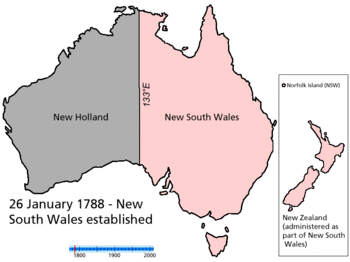
Proposals for new Australian states have been numerous in the past century; however, to date, no states have been added to Australia since Federation in 1901. Many proposals have suggested an Aboriginal state which would resemble the Inuit territory of Nunavut in Canada, while others have suggested incorporating New Zealand, Papua New Guinea, Fiji, East Timor and New Caledonia as new states.[1]
Formation of new states
Chapter VI of the Constitution of Australia allows for the establishment or admission of new states to the Federation. It may also increase, diminish, or otherwise alter the limits of a state, form new states by separating territory from an existing state, or join two states or parts of states, but in each case it must have the approval of the parliaments of the states in question.[2]
Historical proposals

There were proposals for new colonies in the 19th century that did not come about. North Australia was briefly a colony between February and December 1846. The Journal of the Royal Geographical Society published Considerations on the Political Geography and Geographical Nomenclature of Australia in 1838, in which the following divisions were proposed:
- Dampieria in northwestern Australia.
- Victoria in southwestern Australia (not to be confused with the modern Victoria).
- Tasmania in Western Australia (not to be confused with the modern Tasmania).
- Nuytsland near the Nullarbor Plain.
- Carpentaria south of the Gulf of Carpentaria.
- Flindersland in south central Australia.
- Torresia in northern Queensland.
- Cooksland centred on Brisbane.
- Guelphia in southeastern Australia.
- Van Diemen's Land in modern-day Tasmania.
These proposed states were geometric divisions of the continent, and did not take into account soil fertility, aridity or population. This meant that central and western Australia were divided into several states, despite their low populations both then and now.
There was also a proposal in 1857[3] for the "Seven United Provinces of Eastern Australia" with separate provinces of Flinders Land, Leicharts (sic) Land (taken from the name of Ludwig Leichhardt) and Cooks Land in modern day Queensland (also named from James Cook).
Auralia
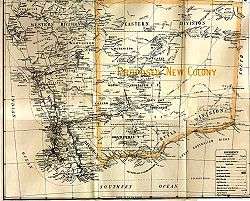

Proposed in the late 19th and early 20th centuries, the state of Auralia (meaning "land of gold") would have comprised the Western Australian Goldfields, the western portion of the Nullarbor Plain and the port town of Esperance.[4] Its capital would have been Kalgoorlie.
However, the population in the modern region of Goldfields-Esperance is currently lower than that of the Northern Territory, and there is little evidence of recent support, although the idea of a state centred around Kalgoorlie was proposed in 2003.[5]
Illawarra Province
Also known as the Illawarra Territory, this proposed new state would consist of the Illawarra region centred on Wollongong on the New South Wales south coast. Originally this idea arose after disagreements between local landowners and migrants from Sydney in the mid-19th century. However the idea has continued in various incarnations ever since with most movements proposing the state's capital be situated in "Illawarra City", or the amalgamation of the Shellharbour and Kiama local government areas.
North Coast
This proposed state takes in the northern part of New South Wales from Taree to the Queensland Border,[6] mainly in the north east, and excluding most of north west NSW.
South Coast
There was a small movement in the 1940s to create a new state in south-east New South Wales and north-east Victoria. The proposed state would have reached from Batemans Bay on the coast to Kiandra in the Snowy Mountains, and as far south as Sale in Victoria. The proposed state capital was Bega. Despite calls from local advocacy groups for a Royal Commission into the idea, it was met with little success.[7]
Princeland
This proposed colony resulted from a movement in the 1860s to create a new colony that incorporated the isolated western Victoria and south-eastern South Australia regions centred on Mount Gambier and Portland. A petition was presented to Queen Victoria, but was rejected.[8]
East Timor
During the process of Portuguese decolonisation in East Timor in 1974, a political party was formed called ADITLA Associação Democrática para a Integração de Timor Leste na Austrália (Democratic Association for the Integration of East Timor into Australia) by local businessman Henrique Pereira. It found some support from the ethnic Chinese community, fearful of independence or integration with Indonesia but was disbanded when the Australian government rejected the idea in 1975.[9]
Former territories
Central Australia
In 1927 the Northern Territory administrator devolved authority for the governing of the southern portion of the territory known as Central Australia, with power vested in an administrator resident in Alice Springs. The arrangement was discontinued in 1931.
Papua New Guinea
Papua New Guinea is physically closest of any country to geographically remote Australia, with some of the Torres Strait Islands just off the main island of the country. In 1953, the editor of the conservative Quadrant magazine, Professor James McAuley, wrote that the territory would be "a coconut republic which would do little good for itself", and advocated its "perpetual union" with Australia, with "equal citizenship rights",[10] but this was rejected by the Australian government.[11] Papua New Guinea was granted self-government and full independence in 1975.
Proposals
Since 2000, proposals for reorganisation have continued to be put forward.[12] For instance, in 2003, Bryan Pape suggested a reorganisation into about twenty states, each with Senate representation.[13]
Republicanism, changing mineral wealth and tax distribution have been seen as reasons to revisit federation. Proposals include redivision between the local, state and federal levels of government either consolidation or fragmentation. It has been argued that new technologies in service delivery are enablers of greater decentralisation or are a reason for greater efficiency in centralisation.
Australian Capital Territory

The ACT has a small number of vocal statehood supporters, who believe the ACT, with a population only slightly less than that of Tasmania, is under-represented in the Australian Parliament. This movement may be likened to supporters of statehood for the District of Columbia in the United States, though it is much smaller and no prominent political figures have given it their support. Furthermore, the wording of s.125 of the Australian Constitution states that the ACT must remain a territory and cannot become a state.
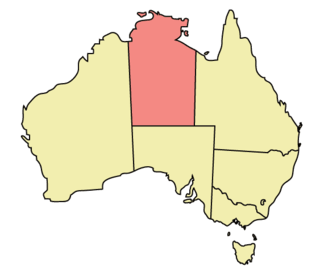
Northern Territory
The Northern Territory is the most commonly mentioned potential seventh state. In a 1998 referendum, the voters of the NT rejected a statehood proposal that would have given the territory three senators, rather than the twelve held by the other states, although the name "Northern Territory" would have been retained. With statehood rejected, it is likely that the Northern Territory will remain a territory for the near future, though former Chief Minister Clare Martin[14] and the majority of Territorians[15] are said to be in favour of statehood. The main argument against statehood has been the NT's relatively low population, and the fact that ordinarily, statehood would give the NT the same number of senators as every other state, despite the largest state New South Wales having over thirty times its population. This means that whilst one NSW senator represents more than 600,000 people, one NT senator would represent approximately 20,000.
An alternative name for the new state would be North Australia, which would be shared by two historic regions.
The matter was raised again in July 2015, with a further referendum in 2018 being mooted.[16]
Queensland
North Queensland
One proposal is that Queensland should be divided by the 22nd parallel with the boundary running just south of Sarina on the coast to the Northern Territory border between Boulia and Mount Isa, and the capital would be Sellheim, near Charters Towers, to overcome rivalry between Mackay, Townsville and Cairns.[17]
According to the Courier-Mail in 2010, the majority of North Queensland Mayors were in favour of the separation from Queensland proper. Only two of the hundred delegates at the NQ Local Government Association meeting were against the proposal – the two being Mayor Val Schier (Cairns) and Mayor Ben Callcott (Charters Towers).[18]
New South Wales
New England
New England is a region of New South Wales and a proposed state. Some supporters also propose a "River-Eden" state in the south of NSW.[12]
Riverina
Riverina is also a proposed state,[13] in the River Murray region, on the border between New South Wales and Victoria. The Division of Riverina is currently a smaller area than traditional Riverina, which would include the Division of Farrer. Along with the ACT, it is one of the few landlocked proposed states.
Aboriginal state
There are also supporters of an Aboriginal state, along the lines of the recently created Nunavut in Canada. The Aboriginal Provisional Government was established in 1990 for the purpose;[19] Paul Coe sued the Commonwealth for Aboriginal sovereignty (Coe v Commonwealth [1979] HCA 68) and see Kevin Gilbert 'Treaty 88'. All advocated for an Aboriginal state.[20] Agence France Presse (21 August 1998) claims Australia blocked a United Nations resolution calling for the self-determination of peoples, because it would have bolstered support for an Aboriginal state within Australia.[21] Among those supporting such a state are the Council for Aboriginal Reconciliation.[22]
New Zealand
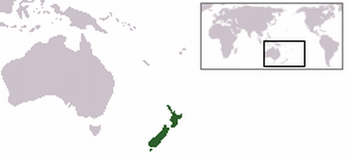
There have been several proposals for New Zealand to become the seventh state of Australia. One of the proposals suggests that New Zealand's North Island and South Island could become separate states in the Commonwealth, which would provide New Zealand interests with a greater say.[23] New Zealand was one of the colonies asked to join in the creation of the Commonwealth of Australia, even by the time the Commonwealth of Australia Constitution Act 1900 (Imp) was enacted, that law still provided for New Zealand to be one of the potential states of Australia.[24] As ties have grown closer, people have made proposals for a customs union, currency union and even a joint defence force. New Zealand and Australia enjoy close economic and political relations, mainly by way of the Trans-Tasman Travel Arrangement, Closer Economic Relations (CER) free trade agreement signed in 1983 and the Closer Defence Relations agreement signed in 1990. In 1989, former Prime Minister of New Zealand Sir Geoffrey Palmer said that New Zealand had "gained most of the advantages of being a state of Australia without becoming one". The two countries, along with the USA, are in ANZUS, but New Zealand's opposition to nuclear weapons has weakened this treaty.
History
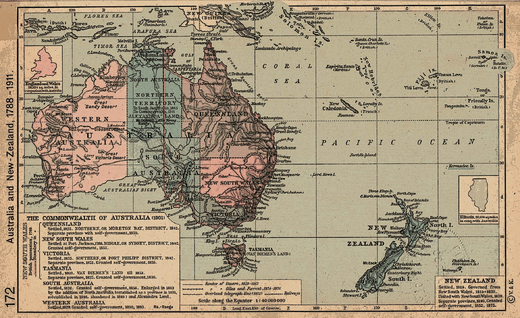
In 1788 Arthur Phillip assumed the position of Governor of New South Wales, claiming New Zealand as part of New South Wales. In 1835 a group of Māori chiefs signed the Declaration of Independence, which established New Zealand as a sovereign nation. A few years later the Treaty of Waitangi re-established British control of New Zealand. The Federal Council of Australasia was formed with members representing New Zealand, Victoria, Tasmania, South Australia and Fiji. Although it held no official power it was a step into the establishment of the Commonwealth of Australia.
In 1890, there was an informal meeting of members from the Australasian colonies, this was followed by the first National Australasian convention a year later. The New Zealand representatives stated it would be unlikely to join a federation with Australia at its foundation. but it would be interested in doing so at a later date. New Zealand's position was taken into account when the Constitution of Australia was written up. New Zealand did not join because of fears of racist laws towards the Māori from the treatment of the Australian Aboriginal people. Australia, in an attempt to sway New Zealand to join, gave Māori the right to vote in 1902, while Australian Aboriginal people did not gain the right to vote until 1967. In 1908 and 1912, Australia and New Zealand sent Australasians teams to the Olympic Games. New Zealand and Australian soldiers fought together in 1915 under the name ANZAC.
Australian academic Bob Catley wrote a book titled Waltzing with Matilda: should New Zealand join Australia?, a book arguing that New Zealand should become one with Australia. In December 2006, an Australian Federal Parliamentary Committee recommended that Australia and New Zealand pursue a full union, or at least adopt a common ANZ currency and more common markets. The Committee found that "while Australia and New Zealand are of course two sovereign nations, it seems... that the strong ties between the two countries – the economic, cultural, migration, defence, governmental and people-to-people linkages – suggest that an even closer relationship, including the possibility of union, is both desirable and realistic." This was despite the Australian Treasurer Peter Costello and New Zealand Minister of Finance Michael Cullen saying that a common currency was "not on the agenda".[25]
A recent UMR research poll asked 1000 people in Australia and New Zealand a series of questions relating to New Zealand's becoming the seventh state of Australia. One quarter of the people thought it was something to look into. Over 40% thought the idea was worth debating. More Australians than New Zealanders would support such a move.[26]
Advantages
There are many reasons people have called for New Zealand to become the seventh state of Australia. Some of the reasons depend which side of the Tasman the person is on. A prominent reason appears to be the two countries are very alike, from their similar flags to their cultural values. Anzac Spirit, one of the foundations of Australian nationalism, is based on Australia and New Zealand's shared heritage. According to the UMR poll results most people believe the New Zealand economy and the ease of travel between countries would be better if New Zealand joined Australia.[26]
A leading factor for the proposal of New Zealand as a state of Australia is the major economic benefits it would bring. However, free trade and open borders now appear to be the maximum extent of public acceptance of the proposal. There are many family connections between the two nations, with around 565,000 New Zealanders living in Australia and 63,000 Australians living in New Zealand as of 2013. Peter Slipper, a former Member of Australia's Parliament, once said, "It's about how can we improve the quality of living for people on both sides of the Tasman" when referring to the proposal.[27]
Disadvantages
The main reason for New Zealanders refusing the proposal is not wanting to be labelled an "Australian".[27] Concerns have been expressed about the need for a common currency, about changes to the South Pacific Nuclear Free Zone Treaty, and about the retention of the administrative and political recognition of the ancestral rights of the indigenous Maori population under the Treaty of Waitangi.
A number of disparities that could lead to conflict including the current constitutions (written in Australia, unwritten in New Zealand), the bills of rights (constitutionally entrenched in Australia but not in New Zealand), and social issues such as same-sex marriage (legal in New Zealand but not in Australia). Some New Zealanders feel they have established a national identity, one which they feel they may lose if they became part of Australia.[26] Others argue New Zealand is too far away from the mainland of Australia.
See also
- Australian regional rivalries
- Proposed provinces and territories of Canada
- Secessionism in Western Australia
- 51st state
- List of regions in Australia
- Australia – New Zealand relations
- Australia – Papua New Guinea relations
- New Australia
- Pacific Union
References
- ↑ Blogger, Guest (16 June 2008). "New Caledonia: What now after twenty years of peace?". Lowyinterpreter.org. Retrieved 2010-04-29.
- ↑ Commonwealth of Australia Constitution Act, Chapter VI Commonwealth of Australia, 2003. Retrieved 2007-12-07. Archived 11 October 2007 at the Wayback Machine.
- ↑ "Digital Collections – Maps – Map of the proposed seven united provinces of eastern Australia [cartographic material]". Nla.gov.au. Retrieved 2010-04-29.
- ↑ "Auralia". Western Australia and Federation. State Library of Western Australia. Retrieved 2016-04-14.
- ↑ Gregory, Denis (2003-05-01). "The man who's creating a United States of Australia". Sun-Herald. Retrieved 2016-04-14.
- ↑ http://www.newstates.com.au/voting.html
- ↑ "NLA Australian Newspapers – article display". Ndpbeta.nla.gov.au. Retrieved 2010-04-29.
- ↑ "Lateline – 22/09/2003: A Suitable Consort . Australian Broadcasting Corp". Abc.net.au. 22 September 2003. Retrieved 2010-04-29.
- ↑ "The Chinese and Aditla" p. 58 in Timor: A Nation Reborn, Nicol, Bill, Equinox Publishing, 2002. [Accessed 26 May 2008.]
- ↑ McAuley, James "Australia's Future in New Guinea", Pacific Affairs, Vol. 26, No. 1 (Mar., 1953), pp. 59–69. [Accessed 25 May 2008. cited by Kiernan, Ben in "Cover-Up and Denial of Genocide: Australia, the USA, East Timor and the Aborigines" Critical Asian Studies, Yale University, p.169
- ↑ "London Constitutional Conference" in Fiji, Brij V Lal, University of London, Institute of Commonwealth Studies, 2006. [Accessed 26 May 2008.]
- 1 2 Lewis, Daniel (25 January 2005). "Altered states". Sydney Morning Herald. Retrieved 2012-12-14.
- 1 2 "The man who's creating a United States of Australia". smh.com.au. 11 May 2003. Retrieved 2010-04-29.
- ↑ Barker, Anne (22 May 2003). "NT statehood back on the agenda". abc.net.au. Retrieved 4 October 2013.
- ↑ House Standing Committee on Legal and Constitutional Affairs (28 May 2007). "Federal implications of statehood for the Northern Territory - Chapter 3: Recent developments towards statehood" (PDF). Parliament of Australia. Retrieved 4 October 2013.
- ↑ " 'Crocland' may become new Australian state", The Daily Telegraph, London, 24 July 2015.
- ↑ "Push for separation as Queensland splits". News.com.au.
- ↑ "The state of North Queensland?". Menzies House.
- ↑ "Aboriginal Provisional Government". apg.org.au.
- ↑ https://web.archive.org/web/20070327234641/http://melbourne.indymedia.org/news/2004/01/61201.php. Archived from the original on 27 March 2007. Retrieved 14 November 2006. Missing or empty
|title=(help) - ↑ Archived 6 September 2006 at the Wayback Machine.
- ↑ "The Sydney Line". The Sydney Line. Retrieved 2010-04-29.
- ↑ "unitedstatesofaustralia.com". unitedstatesofaustralia.com. Archived from the original on 19 January 2011. Retrieved 2010-04-29.
- ↑ Section 6, Commonwealth of Australia Constitution Act 1900 (Imperial)
- ↑ Dick, Tim, "Push for union with New Zealand", Sydney Morning Herald, 5 December 2006. Accessed 29 February 2007.]
- 1 2 3 "Full UMR research poll results on Aust-NZ union". Television New Zealand. 14 March 2010. Retrieved 4 November 2011.
- 1 2 "Q+A Poll – Should NZ & Australia Become One ?". scoop.co.nz.
